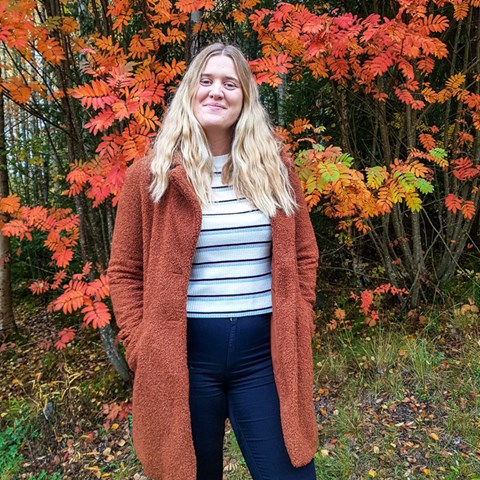Facts:
Do your Master's thesis at our Department
Interested in doing your Master's thesis at the Dept. of Wildlife, Fish and Environmental Studies? Here you'll find more info.

Is there a connection between which wildlife visit our gardens depending on whether there are cats nearby? Master student Kajsa Johansson has investigated this. In the data she analyzed in her thesis, there was a clear connection between cats and the urban environment. She also saw that magpies were found in gardens with few visits by cats, while songbirds were found in gardens with more visits by cats.
My name is Kajsa and with an interest in sustainability and the sustainable use of our natural resources, I decided to study the forestry program here at SLU, Umeå. During my time of education, I came to develop a greater interest in wildlife management as well as their conflicts. I, therefore, chose to write my master thesis at the Department of Wildlife, Fish, and Environmental Studies in the project Meet your wild neighbours.
In my thesis, I have looked into the effects of domestic cats on wildlife and if there is a difference in this effect over an urbanisation gradient. I did my thesis in a citizen science project called Meet your wild neighbours that used camera traps to investigate which wild animals are living in Umeå municipality. In my thesis I try to answer two research questions:
I could see that magpies visited gardens with a low frequency of visits by cats more often than gardens with more cats, while other songbirds showed the opposite pattern.
My results showed that cats have a positive connection with urbanization, which means that I could not answer my second question asking if the effect of domestic cats on wild animals depends on where in the landscape it is (urban or rural).
I chose to write about the effect of domestic cats on wildlife because it has become a global question how much domestic and feral cats impact wildlife. While many studies on the subject have been done in around the world, there are very few studies on the subject from Sweden. Since there are so few previous studies done in Sweden, I thought it would be interesting to see if the results I got would be the same as in other places in the world.
I am very happy that I have chosen to be a student at SLU, and I am so happy that I chose to do my master thesis at the Department of Wildlife, Fish, and Environmental Studies. I have had an incredibly good supervisor during my thesis, who has been a great support and easy to brainstorm ideas with.
Interested in doing your Master's thesis at the Dept. of Wildlife, Fish and Environmental Studies? Here you'll find more info.